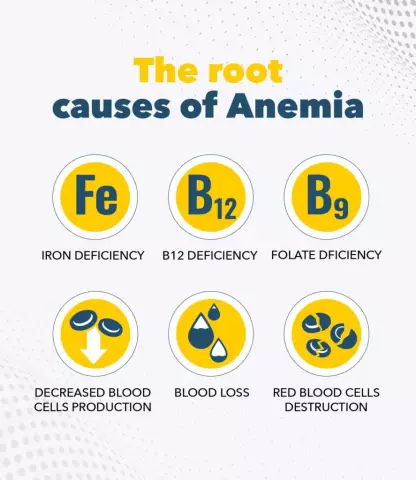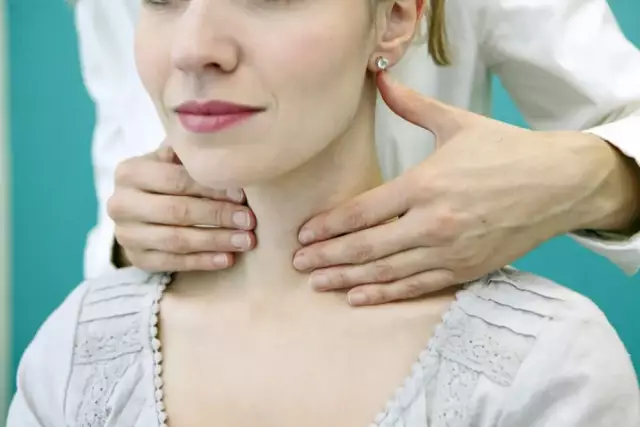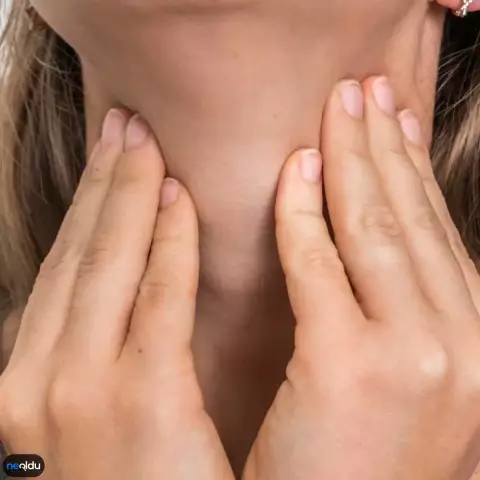- Author Rachel Wainwright [email protected].
- Public 2023-12-15 07:39.
- Last modified 2025-11-02 20:14.
Anemia

In the overwhelming majority of cases, a low concentration of hemoglobin in human blood is associated with a deficiency of iron in the body. This condition is called anemia, and according to official medical statistics, it is diagnosed in almost 20 percent of the population.
The normal content of hemoglobin in the body of an adult healthy person is determined in the following range: 115-145 g / l for women and 132-164 g / l for men.
Along with a decrease in hemoglobin with anemia, there is also a decrease in the number of erythrocytes in the blood (red blood cells).
Causes of anemia
Among the main causes of iron deficiency and subsequent anemia are significant blood loss arising from extensive operating room, stomach, uterine, nosebleeds; as well as with constant donation.
In addition to prolonged bleeding, accompanied by profuse blood loss, acute and chronic diseases of the gastrointestinal tract, in which the function of iron absorption in the human body is disturbed, can serve as the causes of anemia.
Periods of increased body demand for iron preparations are also accompanied by a decrease in hemoglobin in the blood. Often this condition develops in women during pregnancy, childbirth and breastfeeding.
The causes of anemia can be clearly attributed - long-term vegetarianism, malnutrition, strict adherence to hungry diets. All of the listed shortcomings and inaccuracies in nutrition significantly increase the risk of developing anemia, even in a perfectly healthy person.
The causes of anemia in children lie in the still physiologically immature blood-forming system of the child. Anemia progresses in children against the background of the same unfavorable factors listed above as in the adult population.
The degree of anemia

Experts distinguish three main degrees of anemia, which are subdivided into mild, moderate and severe. Determining by eye, without using laboratory tests, to what degree of anemia a particular case of the disease belongs, it is very difficult even for a medical worker. The fact is that the main criterion for the degree of anemia is the level of hemoglobin and its level can be determined solely on the basis of a patient's blood test.
Mild, first-degree anemia is characterized by an insignificant decrease in the level of hemoglobin with the following indicators - 100-120 g / l in men and 90-110 g / l in women.
Typically, patients do not experience any change in their condition. As a treatment for this type of anemia, diet and consumption of foods with a high iron content are recommended.
With the second, moderate degree of anemia, hemoglobin has a more significant degree of decrease - up to 70-80 g / l. This condition is characterized by the appearance of the following symptoms of anemia and complaints: headaches, light dizziness, etc. In this case, one dietary adjustment is not enough, and iron medications are prescribed.
Severe, third degree anemia is already considered life-threatening. Hemoglobin drops to 70 g / l and below. There are violations in the work of the cardiovascular system, blood thinning occurs, the general condition of the body is significantly deteriorating.
Symptoms of anemia
The general symptoms characteristic of anemia are as follows. Patients usually complain of increased fatigue, weakness, tremors (tremors), and constant dizziness. With the further progression of the disease with anemia, the development of syncope is also possible.
The appearance of anemic people is easily determined by physical examination. The skin of such patients is dry and has a very pale, sometimes bluish tint, the mucous membranes are also unnaturally pale in color.
Even a slight physical activity causes severe shortness of breath and palpitations in an anemic person. Without timely treatment for anemia, patients may develop symptoms of coronary heart disease.
Treating anemia

Regular consumption of iron-containing food can be recommended as the main means for self-treatment of anemia and prevention of its occurrence. These means include a whole list of affordable and inexpensive plant products that grow in our domestic beds.
Carrots, beets, sorrel, celery, pumpkin, rutabagas, turnips - all these vegetables, eaten daily as salads or freshly squeezed juices, will become a reliable obstacle to the emergence of such a serious disease as anemia.
In addition to garden vegetables, it is advisable to take infusions and decoctions of some wild plants to treat anemia. Clover flowers, dandelion roots, nettles and many other natural preparations will effectively help you to increase the level of hemoglobin in your blood.
YouTube video related to the article:
The information is generalized and provided for informational purposes only. At the first sign of illness, see your doctor. Self-medication is hazardous to health!






